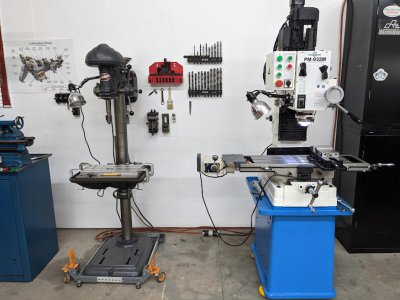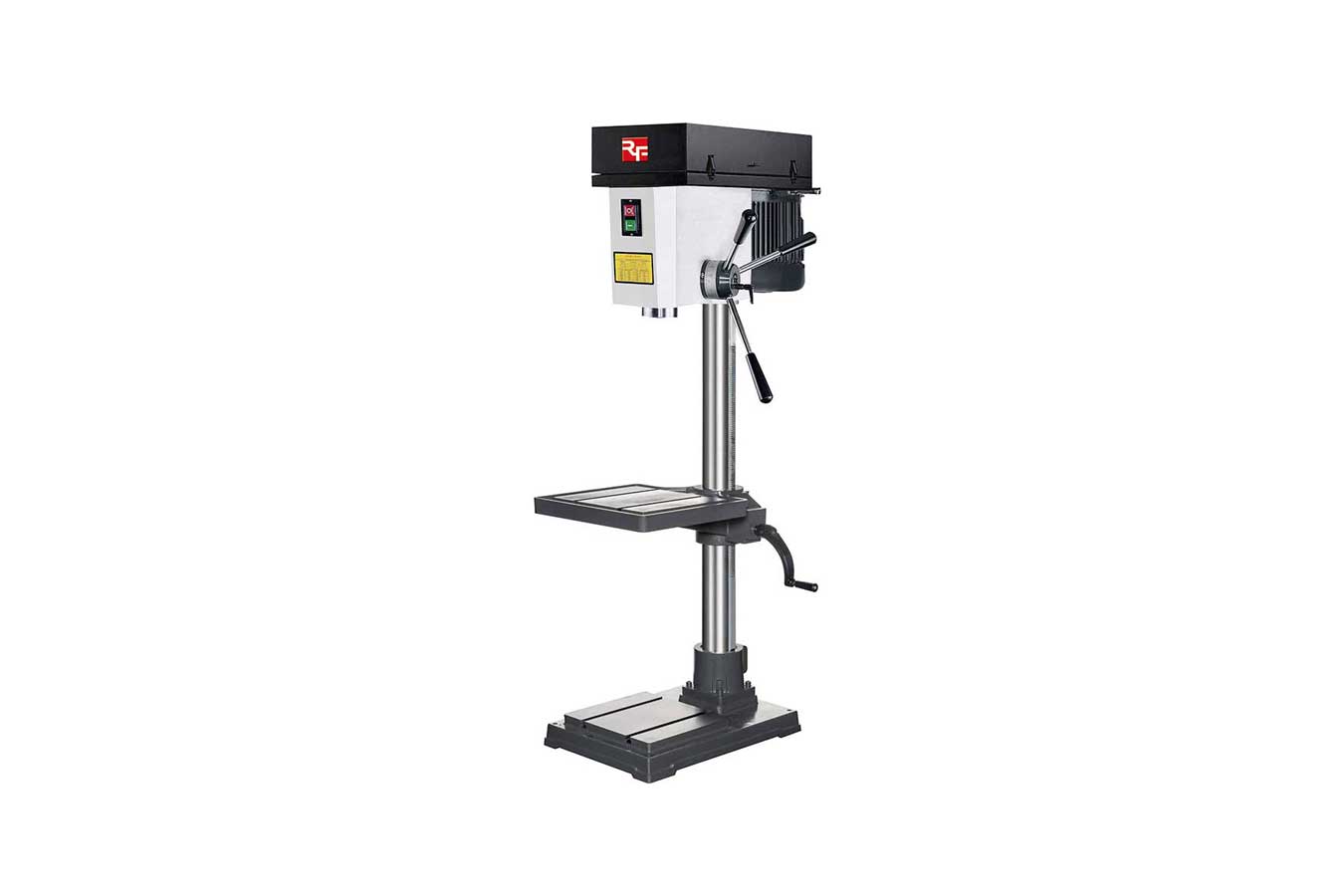Do I need a drill press if I have a mill? It’s a common question that woodworking and metalworking enthusiasts often ask. You might be wondering if these two tools serve the same purpose, or if one can be substituted for the other. Well, let’s dive in and explore the similarities and differences between a drill press and a mill.
Think of a drill press as the precision tool for creating holes in materials. With its stable base and straight up-and-down drilling motion, it’s perfect for accurately drilling holes at specific depths and angles.
On the other hand, a mill is a versatile machine that can do much more than just drilling holes. It can perform milling, boring, reaming, and other operations, thanks to its ability to move the workpiece in various directions and angles.
So, if you’re wondering whether you need a drill press if you have a mill, stick around! In this article, we’ll take a closer look at the functions of each tool and help you determine if they can complement each other or if one can truly replace the other. Let’s get started!

Do I Need a Drill Press if I Have a Mill?
In this article, we will explore the question of whether or not you need a drill press if you already have a mill. Both tools have their own unique functions and capabilities, so it’s important to understand the differences and determine which one is the most suitable for your needs.
Understanding the Functions of a Drill Press and a Mill
Before we delve into the question, let’s first understand the functions of a drill press and a mill. A drill press is primarily used for drilling repeated, accurate holes in a variety of materials. It is designed to perform vertical drilling tasks and is equipped with a chuck that securely holds the drill bit in place. On the other hand, a mill is a versatile machining tool that can perform a range of functions including drilling, milling, cutting, and shaping metal or other solid materials. It utilizes rotary cutters to remove material from the workpiece.
Functionality of a Drill Press
A drill press is specifically designed for drilling operations. It provides precise control over drilling depth, speed, and accuracy. The vertical orientation of the drill press allows for consistent and straight drilling, making it ideal for tasks such as creating holes in wood, metal, or plastic materials. It is equipped with a table that can be adjusted to the desired height and angle, providing stability and support for the workpiece. The drill press offers a reliable and efficient way to achieve consistent results when drilling holes of various sizes.
Moreover, a drill press often comes with additional features such as a built-in laser guide, adjustable depth stop, and variable speed settings. These features enhance its functionality and make it a valuable tool for woodworking, metalworking, and other drilling applications. It is important to note that while a drill press can perform drilling operations on a mill, it lacks the versatility and precision of a dedicated milling machine.
Benefits of Using a Mill
While a drill press is excellent for drilling holes, a mill offers a broader range of functionality. A mill can perform drilling, milling, and other machining operations, allowing for more complex and precise work. It is equipped with a wide range of cutting tools, such as end mills and face mills, which enable it to shape, cut, and machine metal or other solid materials with precision. This makes the mill a preferred choice for tasks that require intricate designs, precise measurements, and custom shaping. The ability to control multiple axes, such as X, Y, and Z, further enhances the mill’s capabilities for intricate machining operations.
Additionally, a mill offers the advantage of customization and versatility. It allows for the creation of unique parts and components with complex shapes and dimensions. With the ability to control the speed and feed rate, a mill can produce smooth finishes and tight tolerances. This makes it suitable for prototyping, small-scale production, and even large-scale manufacturing. However, it is important to note that mills are generally more expensive and require a higher level of skill and knowledge to operate compared to a drill press.
Drill Press vs. Mill: When to Use Which?
Now that we understand the functionalities and benefits of both a drill press and a mill, let’s discuss when to use which tool. If your primary task involves drilling repetitive holes with precise accuracy, a drill press would be the most suitable choice. It offers stability, accuracy, and control for drilling operations, making it ideal for woodworking, metalworking, and other similar tasks.
On the other hand, if you require more versatility and the ability to perform milling operations, a mill is the better option. It allows for more complex machining tasks, such as cutting keyways, milling slots, creating threads, and machining intricate parts. A mill provides precise control over all axes, enabling the creation of detailed and custom designs.
Conclusion
In conclusion, whether or not you need a drill press if you have a mill depends on your specific requirements. While a drill press is excellent for drilling repetitive holes with accuracy, a mill offers a wider range of functionality and versatility for machining operations. Consider the nature of your work and the tasks you wish to accomplish to determine which tool is the most suitable for your needs. Both a drill press and a mill have their own unique capabilities and benefits, so it’s important to choose the tool that aligns with your requirements.
Key Takeaways: Do I Need a Drill Press If I Have a Mill?
- A drill press and a mill are two different tools that serve different purposes.
- If you have a mill, you can perform drilling operations similar to a drill press.
- However, a drill press offers specialized features and is better suited for precise drilling tasks.
- Having both a drill press and a mill can provide versatility and efficiency in different projects.
- Consider your specific woodworking or metalworking needs to determine whether you need a drill press alongside your mill.
Frequently Asked Questions
Below, we’ve compiled some common questions about whether or not you need a drill press if you already have a mill:
1. Can a mill serve the same purpose as a drill press?
While a mill and a drill press may appear similar, they serve different purposes. A mill is primarily used for cutting, shaping, and finishing metal or other materials. It offers precise control and can perform complex tasks like milling keyways or making intricate cuts. On the other hand, a drill press is specifically designed for drilling holes with precision and accuracy. It allows vertical drilling and ensures consistent depth, making it ideal for repetitive drilling tasks.
So, while a mill can be used for drilling, it may not offer the same level of precision and speed as a dedicated drill press. If your work involves a lot of drilling operations, investing in a drill press can save you time and provide better results.
2. What are the advantages of using a drill press with a mill?
By combining a drill press with a mill, you can expand the capabilities of both machines. A drill press can be mounted on the mill’s worktable, allowing for accurate and controlled vertical drilling operations. This combination allows you to perform milling and drilling tasks simultaneously, eliminating the need for separate setups and saving valuable time and effort. Additionally, the drill press’s built-in depth stop and precision controls can enhance the accuracy of your milling operations.
Utilizing a drill press with a mill provides more versatility and efficiency, making it a valuable addition to your workshop, especially if you frequently perform milling and drilling operations on various materials.
3. Can a mill replace a drill press entirely?
While a mill can perform many of the functions of a drill press, it may not be able to replace it entirely. A mill offers greater flexibility when it comes to cutting and shaping materials, including drilling holes. However, a dedicated drill press is purpose-built for drilling tasks and provides superior speed, accuracy, and simplicity for repetitive drilling operations. The chuck mechanism on a drill press allows for quick bit changes and easy securing of workpieces, which is not always as convenient on a mill.
If your work involves predominantly drilling operations, a drill press should still be considered an essential tool in your workshop. It will save you time and effort, while providing consistent results.
4. When should I use a drill press instead of a mill?
A drill press is particularly useful when you need to perform repetitive drilling tasks that require precision and consistency. Its built-in depth stop allows you to control the drilling depth accurately, making it ideal for projects like creating evenly spaced holes or drilling holes to a specific depth. The mechanical advantage of a drill press also means that it can handle larger drill bits or drill through tougher materials more efficiently than a mill.
Therefore, if your project primarily involves drilling tasks and you require high precision and ease of use, a drill press is the tool of choice over a mill.
5. Are there any situations where I would need both a drill press and a mill?
There are situations where having both a drill press and a mill can be advantageous. If your work involves complex projects that require both accurate drilling and precise cutting or shaping, having both machines allows you to switch between tasks without the need for frequent setup changes. Additionally, having a dedicated drill press and a mill streamlines your workflow, allowing you to perform operations simultaneously and increasing overall productivity.
Ultimately, the decision to invest in both a drill press and a mill depends on the specific needs of your projects and the level of precision and efficiency you require.

SUCCESS!! Drill to Mill Conversion.
Summary
If you have a mill, you might not need a drill press. A mill can perform many of the same tasks as a drill press, such as drilling holes and making slots. It offers more precision and versatility, making it a valuable tool to have in your workshop. However, a drill press is still useful for certain tasks, like repetitive drilling and larger holes. If you can afford both, it’s great to have both tools, but if you can only choose one, a mill would be a good investment.
In conclusion, having a mill can replace the need for a drill press in most situations. It offers more functionality and accuracy. However, a drill press can still be beneficial for specific tasks. Ultimately, the decision depends on your budget and the type of work you plan to do.
